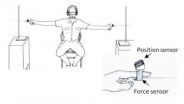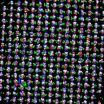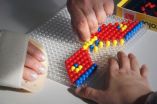(Press-News.org) Boulder, CO, USA – Not very long ago a professional geologist's field kit consisted of a Brunton compass, rock hammer, magnifying glass, and field notebook. No longer. In the field and in the labs and classrooms, studying Earth has undergone an explosive change in recent years, fueled by technological leaps in handheld digital devices, especially tablet computers and cameras.
Geologist Terry Pavlis' digital epiphany came almost 20 years ago when he was in a museum looking at a 19th-century geology exhibit that included a Brunton compass. "Holy moly!" he remembers thinking, "We're still using this tool." This is despite the fact that technological changes over the last 10 years have not only made the Brunton compass obsolete, but swept away paper field notebooks as well (the rock hammer and hand-lens magnifier remain unchallenged, however).
The key technologies that replace the 19th-century field tools are the smart phone, PDA, handheld GPS, and tablet PC and iPad. Modern tablets, in particular, can do everything a Brunton compass can, plus take pictures and act as both a notebook and mapping device, and gather precise location data using GPS. They can even be equipped with open-source GIS software.
Pavlis, a geology professor at The University of Texas at El Paso, and Stephen Whitmeyer of James Madison University will be presenting the 21st-century way to do field geology on Monday, 5 Nov., at the meeting of the Geological Society of America (GSA) in Charlotte, N.C. The presentations are a part of a digital poster Pardee Keynote Symposium titled, "Digital Geology Speed-Dating: An Innovative Coupling of Interactive Presentations and Hands-On Workshop."
"I had a dream we would not be touching paper anymore," says Pavlis. "I'm now sort of an evangelist on this subject."
That's not to say that the conversion to digital field geology is anywhere near complete. The new technology is not quite catching on in some university field courses because the technology is more expensive and becomes obsolete quickly, says Pavlis.
"Field geology courses are expensive enough for students," he notes. As a result, the matter of teaching field geology with digital tools is actually rather controversial among professors.
Meanwhile, on the classroom side of earth science education, there are new digital tools that bring the field into the classroom. One of them is GigaPans - gigantic panorama images.
"A GigaPan is basically a really big picture that's made of lots of full-resolution zoomed-in photos," explains geologist Callan Bentley of Northern Virginia Community College. To make a GigaPan, you need a GigaPan Robot that looks at the scene and breaks it into a grid, then shoots the grid. That can result in hundreds or even thousands of images. The GigaPan system then stitches them together. The resulting stitched image is uploaded to the GigaPan.org website where everybody can see it.
"In geology, we look at things in multiple scales," says Bentley. "A well-composed GigaPan is very useful." Bentley will be presenting GigaPans at the same GSA meeting session as Pavlis, along with others using the latest technology to study and teach geology.
GigaPans were developed by Google, NASA, and the robotics lab at Carnegie Mellon University. Bentley got involved when the "Fine Outreach for Science" program recruited him. Since then, he has documenting geology of the Mid-Atlantic region.
"I have used some of it in the classroom," said Bentley. "I have students look at a scene, make a hypothesis then look closer to test the hypothesis."
### CONTACTS:
Terry Pavlis
+1 (915) 747-5570
Callan Bentley
+1 (540) 933-6244
WHAT:
Session No. 91: Digital Geology Speed-Dating: An Innovative Coupling of Interactive Presentations and Hands-On Workshop
WHEN: 9 a.m. to 6 p.m., Monday, 5 Nov.
WHERE: Charlotte Convention Center: Hall B
GigaPan Examples
Smallest (microscope-scale):
http://gigapan.com/gigapans/12751
http://gigapan.com/gigapans/109041
http://gigapan.com/gigapans/100610
http://gigapan.com/gigapans/86263
Small (hand-sample-scale):
http://www.gigapan.com/gigapans/11403
http://www.gigapan.com/gigapans/2166
http://gigapan.com/gigapans/103122
http://gigapan.com/gigapans/103870
http://gigapan.com/gigapans/98984
http://gigapan.com/gigapans/94714
Medium (outcrop-scale):
http://gigapan.com/gigapans/112956
http://gigapan.com/gigapans/110837
http://gigapan.com/gigapans/75096
http://gigapan.com/gigapans/74776
http://gigapan.com/gigapans/83143
http://gigapan.com/gigapans/90685
Large (landscape-scale):
http://gigapan.com/gigapans/114032
http://gigapan.com/gigapans/10458
http://gigapan.com/gigapans/46259
http://www.gigapan.com/gigapans/57636
http://www.gigapan.com/gigapans/104068
http://www.gigapan.com/gigapans/31687
And, as a bonus, this one is lots of fun:
http://gigapan.com/gigapans/2121
Find out what else is new and newsworthy by browsing the complete technical program schedule at https://gsa.confex.com/gsa/2012AM/finalprogram/.
To identify presentations in specific areas of interest, search topical sessions by discipline categories or sponsors using the drop-down menus at www.geosociety.org/meetings/2012/sessions/topical.asp, or use your browser's "find" feature to search for keywords or convener names.
Representatives of the media and public information officers from universities, government agencies, and research institutions, may participate in technical sessions, field trips, and other special events. Eligible media personnel will receive complimentary registration and are invited to use GSA's newsroom facilities while at the meeting. Journalists and PIOs must pay for any short courses or field trips in which they wish to participate.
For information on media eligibility, go to www.geosociety.org/meetings/2012/media.htm. Media personnel may register onsite in the GSA Newsroom (room 204) at the Charlotte Convention Center. Wireless Internet access and a quiet space for interviews will be provided in the newsroom, along with beverages and light snacks throughout the day.
Newsroom Hours of Operation
Saturday, 3 Nov., 3 p.m. to 5 p.m.
Sunday, 4 Nov., through Tuesday, 6 Nov., 7:30 a.m. to 6 p.m.
Wednesday, 7 Nov., 7:30 a.m. to 5:30 p.m.
Newsroom telephone number (incoming calls): +1-704-339-6207 (starting Saturday afternoon).
Contact Christa Stratton, GSA Director of Communications & Marketing, for additional information and assistance.
www.geosociety.org/meetings/2012/
Rats use a sense that humans don't: whisking. They move their facial whiskers back and forth about eight times a second to locate objects in their environment. Could humans acquire this sense? And if they can, what could understanding the process of adapting to new sensory input tell us about how humans normally sense? At the Weizmann Institute, researchers explored these questions by attaching plastic "whiskers" to the fingers of blindfolded volunteers and asking them to carry out a location task. The findings, which recently appeared in the Journal of Neuroscience, have ...
Autosomal-dominant polycystic kidney disease (ADPKD) is one of the most common genetic disorders, affecting one in every 1,000 people and responsible for up to ten percent of patients on dialysis worldwide. The disease is characterized by the development of cysts that lead to progressive kidney failure and necessitate dialysis or a kidney transplant in most patients aged around fifty. Moreover, the persistent cyst growth causes high blood pressure and painful complications. Although we have known about the disease for over a century and its genetic basis for almost 20 years, ...
Hispanics and Latinos living in the U.S. are highly likely to have several major cardiovascular disease risk factors, such as high cholesterol, high blood pressure, obesity, diabetes, and smoking, according to a new, large-scale study. Risks vary among the diverse Hispanic/Latino groups, but individuals who were born in the U.S. are more likely to have multiple risk factors.
The findings are reported in the Nov. 7 issue of JAMA.
Hispanic and Latino people now comprise the largest minority group in the U.S. Although this population is relatively young, cardiovascular ...
The patients have single short fingers (metacarpals) and toes (metatarsals) and can be restricted in growth due to a shortened skeleton. This hereditary disease is called brachydactyly type E (Greek for short fingers). Three years ago Dr. Philipp G. Maass from the research group of Professor Friedrich C. Luft at the Experimental and Clinical Research Center (ECRC), a joint cooperation between the Charité Medical Faculty and the Max Delbrück Center for Molecular Medicine (MDC) in Berlin-Buch, has discovered an epigenetic mechanism, which, when dysregulated, causes this condition. ...
Europeans spend much time with their grandchildren. And past 70, the grandfather takes the lead.
Norwegian sociologist Knud Knudsen sets great store by his grandchildren. In that respect, he is typical of the grandparents in Europe who are the subjects of his recent research.
"Europeans with grandchildren generally opt to spend a good deal of time with them," says 67-year-old Knudsen, who is professor of sociology at the University of Stavanger (UiS).
"And grandfathers appear to be more involved than before," he adds. In a new study, he found that grandmothers are ...
Philadelphia, PA, November 5, 2012 – New findings led by Dr. Michael Lombardo, Prof. Simon Baron-Cohen and colleagues at the University of Cambridge indicate that testosterone levels early in fetal development influence later sensitivity of brain regions related to reward processing and affect an individual's susceptibility to engage in behavior, that in extremes, are related to several neuropsychiatric conditions that asymmetrically affect one sex more than the other.
Although present at low levels in females, testosterone is one of the primary sex hormones that exerts ...
Researchers at the Bellvitge Biomedical Research Institute (IDIBELL) have led a study published in PLoS One showing that the inhibition of a family member of NADPH oxidase enzyme, NOX4, plays an important role in liver fibrosis.
The researchers studied the function of a cytokine called transforming growth factor-beta (TGF-beta) in the pathophysiology of the liver, which is one of the main research lines of the Biological Clues of the Invasive and Metastatic Phenotype research group at the IDIBELL, leaded by Isabel Fabregat.
This paper is related with the processes of ...
The largest volcanic eruption on Earth in the past millions of years took place in Indonesia 74,000 years ago and researchers from the Niels Bohr Institute can now link the colossal eruption with the global climate and the effects on early humans. The results are published in the scientific journal Climate of the Past.
The volcano Toba is located in Indonesia on the island Sumatra, which lies close to the equator. The colossal eruption, which occurred 74,000 years ago, left a crater that is about 50 km wide. Expelled with the eruption was 2,500 cubic kilometers of lava ...
Washington, D.C.--Researchers at the Carnegie Institution have discovered a new efficient way to pump heat using crystals. The crystals can pump or extract heat, even on the nanoscale, so they could be used on computer chips to prevent overheating or even meltdown, which is currently a major limit to higher computer speeds. The research is published in the Physical Review Letters.
Ronald Cohen, staff scientist at Carnegie's Geophysical Laboratory and Maimon Rose, originally a high school intern now at the University of Chicago carried out the research. They performed ...
In the 'Journal of Neuroscience' (DOI:10.1523/JNEUROSCI.5912-11.2012) the researchers present the results of their study, showing how a local anesthetic can distinctly improve the motor skills of patients after a stroke.
"Many stroke patients suffer from chronic impairment of the hand or of the complete arm," Professor Dr. Thomas Weiss explains. Together with expert colleagues the psychologist of the department of Biological and Clinical Psychology at Jena University has been working for a number of years on a specialized medical training therapy which clearly enhances ...



